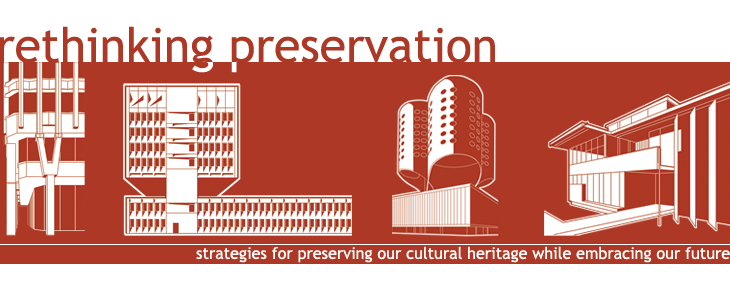

Pictured above are two proposals for Midtown Plaza in Rochester, NY. The Plaza was a 1950s planning experiment aimed at propping up downtown retail business that had diminished with the expansion of suburban shopping centers. Thus it's with some irony that these two proposals each convert the existing office building over the old mall into housing, in some manner suburbanizing the urban in a seeming development trend across the country. A new proposal, yet to be unveiled, is in the works according to rochesterdowntown.com. Midtown Plaza, vacated in 2008, was designed by Victor Gruen. Local historian Dan Palmer believes the building is an integral part of the Rochester skyline and holds great architectural integrity inside and out.
 Dan makes us think about two things: the three-dimensional experience of buildings (above, existing interior), and how many cities across the country have similar prominently located buildings that no longer serve their original purpose for whatever reason. In downtown areas, buildings are part of urban networks; when they are no longer in use or the use changes, the surrounding microeconomy is substantially affected. Because these types of buildings often have flexible interiors for business, many see their facades as the only portion with artistic value.
Dan makes us think about two things: the three-dimensional experience of buildings (above, existing interior), and how many cities across the country have similar prominently located buildings that no longer serve their original purpose for whatever reason. In downtown areas, buildings are part of urban networks; when they are no longer in use or the use changes, the surrounding microeconomy is substantially affected. Because these types of buildings often have flexible interiors for business, many see their facades as the only portion with artistic value.
The first scheme above proposes to clean and retain the original facade, an often-seen approach, while the second proposal uses only the structure and replaces the existing facade with an offset window pattern, also an often-seen trend in housing. Both view the facade as aesthetic wallpaper and represent a lack of three-dimensional thought and historical investigation. While both may solve the financial proforma of development, neither balances historical memory with the authenticity of use. The facades present a false veil to the realities of the street, use, and cultural memory.
As the cultural entourage of the street (our cars, clothes, values, and gadgets) shifts daily, how should the building backdrop shift? Events and actions are recorded on and within buildings throughout time. If we’re afraid to change our historic buildings for fear of losing cultural memory, then we will lose cultural memory by way of forgetting the original intentions, because those original uses are gone. If we erase all existence, then historical lessons are lost. So what then are we really preserving? What is the continuing value? Can we create a new kind of old and new co-existence - one of richly-layered authenticity, modern life, and cultural memory?
 Dan makes us think about two things: the three-dimensional experience of buildings (above, existing interior), and how many cities across the country have similar prominently located buildings that no longer serve their original purpose for whatever reason. In downtown areas, buildings are part of urban networks; when they are no longer in use or the use changes, the surrounding microeconomy is substantially affected. Because these types of buildings often have flexible interiors for business, many see their facades as the only portion with artistic value.
Dan makes us think about two things: the three-dimensional experience of buildings (above, existing interior), and how many cities across the country have similar prominently located buildings that no longer serve their original purpose for whatever reason. In downtown areas, buildings are part of urban networks; when they are no longer in use or the use changes, the surrounding microeconomy is substantially affected. Because these types of buildings often have flexible interiors for business, many see their facades as the only portion with artistic value.The first scheme above proposes to clean and retain the original facade, an often-seen approach, while the second proposal uses only the structure and replaces the existing facade with an offset window pattern, also an often-seen trend in housing. Both view the facade as aesthetic wallpaper and represent a lack of three-dimensional thought and historical investigation. While both may solve the financial proforma of development, neither balances historical memory with the authenticity of use. The facades present a false veil to the realities of the street, use, and cultural memory.
As the cultural entourage of the street (our cars, clothes, values, and gadgets) shifts daily, how should the building backdrop shift? Events and actions are recorded on and within buildings throughout time. If we’re afraid to change our historic buildings for fear of losing cultural memory, then we will lose cultural memory by way of forgetting the original intentions, because those original uses are gone. If we erase all existence, then historical lessons are lost. So what then are we really preserving? What is the continuing value? Can we create a new kind of old and new co-existence - one of richly-layered authenticity, modern life, and cultural memory?




No comments:
Post a Comment